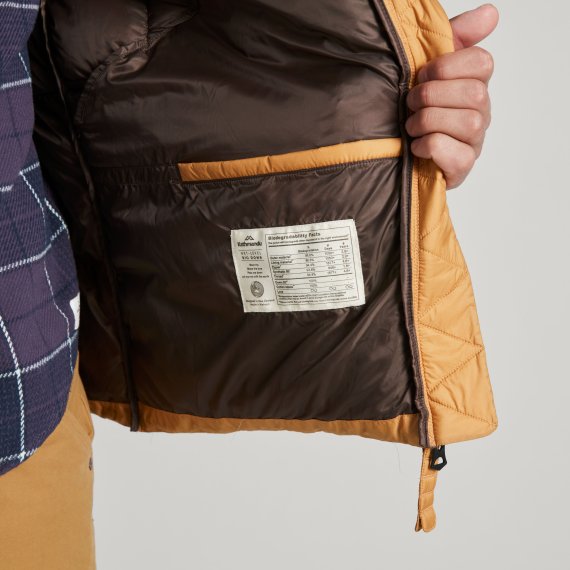
New Zealand-based outdoor brand Kathmandu has committed to designing, developing and manufacturing 100 percent of its products using elements of circularity principles by 2025. For Kathmandu, the key to the circular economy lies in developing products that are as durable as possible, and then biodegradable when they reach modern landfill. Because just one percent of all textile waste worldwide is recycled today. Until functioning recycling plants and processes are developed on a large scale, and in order to reduce the growing mountains of waste, another solution is needed: With the NXT-Level BioDown jacket, Kathmandu presents a biodegradable insulated jacket. It is scheduled to hit the market in the northern hemisphere in fall.
Kathmandu uses nylon 66 to develop the fabric, lining, sewing thread and zipper, and treats these elements with a biodegradable polymer called 'AmniSoul Eco'. All other materials are also biodegradable: the filling is made from PrimaLoft-Bio and with Responsible Down Standard (RDS) 600fill power duck down, traceable with TrackMyDown. Elements external to the jacket were highly considered too, with cotton was used for the labels and 100% recycled card and printed soy ink used for the swing tag.
The challenge was to develop a jacket without all the trims that designers usually fall back on, or to find alternatives.

During the nylon manufacturing process, a special additive is added to accelerate biodegradation in an anaerobic environment. Once in a modern landfill environment, the additive gets activated and enables a biofilm, which is formed by acids and enzymes secreted by microbes, to break down the synthetics long polymer chains which are then excreted as organic matter. This process takes place within three to five years. Conventional synthetic fibers normally take centuries for this process. This is not accomplished in the compost at home, but under the controlled conditions of modern landfill, where most textiles end up.

But of course, biodegradability only makes sense if the product has been used for a long time beforehand. It was therefore important to design an extremely durable, comfortable and desirable product that could be worn for decades. That's why Kathmandu, for example, uses a durable ripstop fabric like the ones used for backpacks. The brand also actively promotes extending the product life through care & repair, passing-on or reselling.
Not only was the garment designed to be biodegradable, this philosophy was carried through to the entire product construction and packaging. From the hangtags, desiccant and polybag to the messenger bag, everything is designed to degrade (in the right environment).
*86.6% biodegradation in 1,050+ days for outer and lining material; 94.4% biodegradation in 1,677+ days for zip and thread; 93.8% biodegradation in 646+ days for synthetic fill under ASTM D5511 conditions (being optimal conditions that may be found in some biologically active landfills)
Soft, warm and lightweight down jacket made only from biodegradable materials, including lining, fill, main materials and zipper
TrackMyDown for down traceability - from farm to shipping to production
Duck down with 600 fill power and Responsible Down Standard (RDS)
Durable PFC free water repellent (DWR) finish
Coherent, holistic circular concept
- ISPO awards
- Mountain sports
- Bike
- Design
- Retail
- Fitness
- Health
- ISPO Job Market
- ISPO Munich
- ISPO Shanghai
- Running
- Brands
- Sustainability
- Olympia
- OutDoor
- Promotion
- Sports Business
- ISPO Textrends
- Triathlon
- Water sports
- Winter sports
- eSports
- SportsTech
- OutDoor by ISPO
- Heroes
- Transformation
- Sport Fashion
- Urban Culture
- Challenges of a CEO
- Trade fairs
- Sports
- Find the Balance
- Product reviews
- Newsletter Exclusive Area
- Magazine



